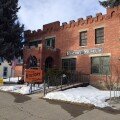Gallatin History Museum Monthly Speaker Series: Duncan Patten

Please join us in welcoming Author/Professor/
Gallatin Canyon and the Road to West Yellowstone – A Changing Pathway Through Time.
The book and the talk which will describe the book uses repeat photography, that is comparison of historic photos and a modern retakes of the same location to show how places and the landscape change (or do not change) over time. The location of the book (talk) is the Gallatin Canyon from its mouth just south of Gallatin Gateway to West Yellowstone. This route, once called the Gallatin Way, was used by many who traveled to the west gate of Yellowstone National Park in West Yellowstone. This was especially true for "tourists" that stayed at the Gallatin Gateway Inn, owned by the Milwaukee Railroad, who were bused through the Canyon to the Park.
Many historic images date before 1900 or in the very early 1900s showing both limited development in the Canyon and the condition of the road which eventually opened all the way to West Yellowstone in 1914. Historic "guest" ranches developed along the way following miners and cattle ranching. Some of the very early "guest" ranches were Karst's Kold Springs Ranch mid –canyon, Michener's cabins at West Fork, Halfway Inn (originally called Dew Drop Inn and now Rainbow Ranch), Buffalo Horn Ranch (now 320 Ranch), and Nine Quarter Circle Ranch which evolved from a cattle ranch. In the 1920s Elkhorn Ranch and Covered Wagon Ranch were established. All the while the road continued to improve with gravel in the 1920s and "pavement" in the mid 1930s. The 1950s/60s saw a major upgrade and change of location in many places for the highway.
In 1908, railroad service was added to West Yellowstone which greatly impacted "tourist" business to the west gate of Yellowstone NP. Increased use of personal cars eventually put Gallatin Gateway out of business. In 1929 the northwest corner of Yellowstone National Park was added to protect the petrified wood "forests" in that area. This corner of the Park had been "managed" by the Army until 1918 when the National Park Service was established and took over the Park. The foundation of the old Soldier's Station is still evident in the NW corner of the Park.
The Canyon saw major changes with development of Big Sky Resort in the early 1970s and tourist business in the Canyon and West Yellowstone greatly increased about that time.
It is interesting to note that many pairs of historical and modern photos show few changes while others, especially where there is development, show major changes over time. Change is inevitable, even if not caused by humans.
Cost: FREE
Age: all ages
Time(s)
This event is over.
Wed. Nov. 1, 2017 6-7:30pm
More Events Like This
| Tweet |
